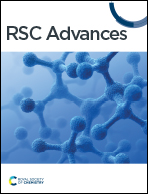A carboxylated cellulose aerogel for the rapid detection of aniline vapor†
Abstract
Although many aniline vapor sensing materials have superior properties based on the quartz crystal microbalance (QCM) platform, they exhibit very slow response. Herein, we report an effective method to evenly synthesize carboxylated cellulose aerogels via 2,2,6,6-tetramethylpiperidine-1-oxy radical (TEMPO)-mediated oxidation. The carboxylated cellulose aerogel was first employed to detect aniline vapor based on a QCM and featured a high response, good selectivity, satisfactory repeatability and stability, and especially rapid response (the response/recovery times were 13 s/8 s, respectively). The Gaussian 09 software was used to simulate the sensing mechanism, which revealed that the weak chemical adsorption between the carboxyl group in the carboxylated cellulose aerogel and the amino group in aniline is the main interaction. These systematic studies show that the carboxylated cellulose aerogel is expected to be a good sensing material for detecting aniline vapor indoors and outdoors.



 Please wait while we load your content...
Please wait while we load your content...